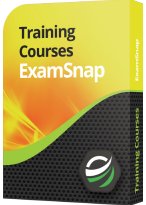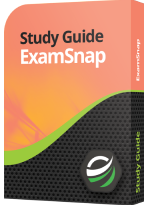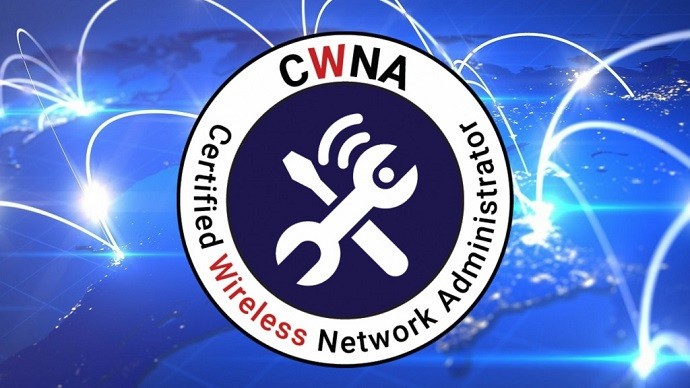
CWNA-108: Certified Wireless Network Administrator
PDFs and exam guides are not so efficient, right? Prepare for your CWNP examination with our training course. The CWNA-108 course contains a complete batch of videos that will provide you with profound and thorough knowledge related to CWNP certification exam. Pass the CWNP CWNA-108 test with flying colors.

Curriculum for CWNA-108 Certification Video Course
| Name of Video | Time |
|---|---|
 1. Course Introduction |
01:36 |
 2. Instructor Introduction |
00:43 |
| Name of Video | Time |
|---|---|
 1. Overview of Wireless Communications |
00:34 |
 2. Overview of Wireless History |
01:09 |
 3. Standards Part1 |
01:14 |
 4. Standards Part2 |
00:52 |
 5. Standards Part3 |
00:39 |
 6. Standards Part4 |
02:22 |
 7. The FCC Part1 |
01:54 |
 8. The FCC Part2 |
01:30 |
 9. ITU-R |
01:56 |
 10. IETF Part1 |
01:24 |
 11. IETF Part2 |
01:25 |
 12. ISOC Hierarchy |
01:42 |
 13. Wi-Fi Alliance |
00:48 |
 14. IEEE |
01:05 |
 15. The Hierarchical Model |
03:25 |
 16. Carrier Signals |
01:21 |
 17. Communication Fundamentals Part1 |
02:38 |
 18. Communication Fundamentals Part2 |
01:22 |
 19. Communication Fundamentals Part3 |
03:04 |
 20. Communication Fundamentals Part4 |
00:22 |
 21. Communication Fundamentals Part5 |
00:33 |
 22. Communication Fundamentals Part6 |
00:52 |
 23. Communication Fundamentals Part7 |
01:03 |
 24. Communication Fundamentals Part8 |
01:20 |
 25. Communication Fundamentals Part9 |
01:09 |
 26. Communication Fundamentals Part10 |
02:03 |
 27. Section Review |
00:54 |
| Name of Video | Time |
|---|---|
 1. Fundamentals of RF |
00:58 |
 2. What is an RF Signal? Part1 |
01:06 |
 3. What is an RF Signal? Part2 |
02:03 |
 4. What is an RF Signal? Part3 |
02:26 |
 5. Characteristics of RF |
00:33 |
 6. Wavelength Part1 |
01:54 |
 7. Wavelength Part2 |
03:46 |
 8. Wavelength Part3 |
03:00 |
 9. Wavelength Part4 |
01:37 |
 10. Frequency Part1 |
01:02 |
 11. Frequency Part2 |
00:29 |
 12. Amplitude |
01:25 |
 13. Phase Part1 |
02:09 |
 14. Phase Part2 |
00:42 |
 15. RF Behaviors |
01:00 |
 16. Absorption |
01:53 |
 17. Reflection |
03:15 |
 18. Scattering |
02:03 |
 19. Refraction |
01:24 |
 20. Diffraction |
00:33 |
 21. Attenuation |
01:05 |
 22. Multipath Part1 |
01:42 |
 23. Multipath Part2 |
01:17 |
 24. Gain |
02:06 |
 25. Section Review |
00:38 |
| Name of Video | Time |
|---|---|
 1. Components and Measurements of RF |
00:44 |
 2. Components of RF Communications |
02:05 |
 3. Transmitter |
01:07 |
 4. Antenna Part1 |
1:36 |
 5. Antenna Part2 |
00:30 |
 6. Receiver |
01:18 |
 7. Intentional Radiator (IR) |
01:43 |
 8. Equivalent Isotropically Radiated Power (EIRP) |
01:47 |
 9. Units of Power and Comparison |
01:50 |
 10. Units of Power |
01:43 |
 11. Watt Part1 |
02:29 |
 12. Watt Part2 |
00:30 |
 13. Decibel (dB) Part1 |
01:16 |
 14. Decibel (dB) Part2 |
00:35 |
 15. dB Mathematics |
03:27 |
 16. dBi Part1 |
02:13 |
 17. dBi Part2 |
01:47 |
 18. dBd Part1 |
00:51 |
 19. dBd Part2 |
01:46 |
 20. dBm |
00:54 |
 21. The 6 dB Rule |
03:25 |
 22. RF Mathematics |
01:01 |
 23. Rule of 10s and 3s Part2 |
01:51 |
 24. Math Examples (eNotes) Part1 |
08:53 |
 25. Math Examples (eNotes) Part2 |
06:19 |
 26. Math Examples (eNotes) Part3 |
04:40 |
 27. Noise Floor |
00:54 |
 28. SNR |
01:13 |
 29. Received Signal Strength Indicator (RSSI) |
02:20 |
 30. RSSI Example |
02:05 |
 31. Section Review |
00:21 |
| Name of Video | Time |
|---|---|
 1. RF Signal and Antenna Concepts Part1 |
00:41 |
 2. RF Signal and Antenna Concepts Part2 |
01:19 |
 3. Azimuth and Elevation Charts (Antenna Radiation Envelopes) Part1 |
01:24 |
 4. Azimuth and Elevation Charts (Antenna Radiation Envelopes) Part2 |
03:05 |
 5. Azimuth and Elevation Charts (Antenna Radiation Envelopes) Part3 |
01:30 |
 6. Azimuth and Elevation Charts (Antenna Radiation Envelopes) Part4 |
01:40 |
 7. Azimuth and Elevation Charts (Antenna Radiation Envelopes) Part5 |
00:37 |
 8. Beamwidth Part1 |
01:13 |
 9. Beamwidth Part2 |
01:51 |
 10. Antenna Types |
03:08 |
 11. Omnidirectional Antenna |
01:47 |
 12. Semidirectional Antenna |
01:29 |
 13. Patch Antenna |
02:29 |
 14. Planar Antenna |
01:04 |
 15. Yagi Antenna |
01:09 |
 16. Highly Directional Antenna |
02:36 |
 17. Antenna Arrays |
01:30 |
 18. Beamforming |
00:31 |
 19. Static Beamforming |
01:04 |
 20. Dynamic Beamforming |
00:59 |
 21. Transmit Beamforming |
00:59 |
 22. Antenna Polarization |
01:14 |
 23. Antenna Diversity |
01:48 |
 24. Multiple -Input, Multiple -Output |
01:58 |
 25. Section Review |
00:40 |
| Name of Video | Time |
|---|---|
 1. IEEE 802.11 |
00:46 |
 2. Original IEEE 802.11 Standard |
03:21 |
 3. IEEE 802.11 -2007 Ratified Amendments |
01:57 |
 4. 802.11b |
02:02 |
 5. 802.11a Part1 |
02:06 |
 6. 802.11a Part2 |
00:55 |
 7. 802.11g |
02:08 |
 8. 802.11 Review |
01:07 |
 9. 802.11i Part1 |
01:45 |
 10. 802.11i Part2 |
01:39 |
 11. 802.11i Part3 |
03:08 |
 12. 802.11r -2008 |
01:24 |
 13. 802.11w |
00:45 |
 14. 802.11n |
00:17 |
 15. 802.11ac |
00:47 |
 16. Section Review |
00:30 |
| Name of Video | Time |
|---|---|
 1. Spread Spectrum Technologies |
00:50 |
 2. Industrial, Scientific, and Medical Bands |
02:16 |
 3. 900 MHz |
00:47 |
 4. 2.4 GHz |
01:49 |
 5. 5.0 GHz |
00:51 |
 6. Unlicensed National Information Infrastructure Bands |
01:28 |
 7. U-NII Review |
01:29 |
 8. 60 GHz |
01:12 |
 9. Narrowband and Spread Spectrum Part1 |
02:18 |
 10. Narrowband and Spread Spectrum Part2 |
01:41 |
 11. Multipath Interference |
01:02 |
 12. Frequency Hopping Spread Spectrum |
01:33 |
 13. Hopping Sequence |
02:33 |
 14. Dwell Time |
01:02 |
 15. Hop Time |
00:39 |
 16. Direct Sequence Spread Spectrum Part1 |
02:03 |
 17. Direct Sequence Spread Spectrum Part2 |
04:13 |
 18. Direct Sequence Spread Spectrum Part3 |
01:31 |
 19. Direct Sequence Spread Spectrum Part4 |
01:12 |
 20. Orthogonal Frequency Division Multiplexing Part1 |
01:31 |
 21. Orthogonal Frequency Division Multiplexing Part2 |
01:27 |
 22. Orthogonal Frequency Division Multiplexing Part3 |
01:50 |
 23. 2.4 GHz |
01:55 |
 24. 2.4 GHz (Cont.) |
00:45 |
 25. 5.0 GHz |
00:46 |
 26. 5.0 GHz (Cont.) |
00:27 |
 27. Adjacent, Nonadjacent, and Overlapping Channels |
01:33 |
 28. Throughput vs. Bandwidth |
00:54 |
 29. Section Review |
00:30 |
| Name of Video | Time |
|---|---|
 1. WLAN Topologies |
00:20 |
 2. Wireless Networking Topologies |
00:37 |
 3. Wireless Wide Area Network (WWAN) |
01:35 |
 4. Wireless Metropolitan Area Network (WMAN) |
00:41 |
 5. Wireless Personal Area Network (WPAN) |
01:09 |
 6. Wireless Local Area Network (WLAN) |
00:44 |
 7. 802.11 Topologies |
00:59 |
 8. Access Points |
03:51 |
 9. Distribution Service |
00:32 |
 10. SSID |
01:39 |
 11. BSS |
00:54 |
 12. ESS Part1 |
00:58 |
 13. ESS Part2 |
01:01 |
 14. Roaming Part1 |
01:04 |
 15. Roaming Part2 |
00:43 |
 16. Roaming Part3 |
00:57 |
 17. Mesh BSS Part1 |
01:42 |
 18. Mesh BSS Part2 |
01:14 |
 19. WLC Roaming (eNotes) |
06:20 |
 20. Access Point Modes |
04:17 |
 21. Client Station Modes Part1 |
00:44 |
 22. Client Station Modes Part2 |
00:55 |
 23. Section Review |
00:13 |
| Name of Video | Time |
|---|---|
 1. Wi -Fi Access |
00:38 |
 2. CSMA/CA vs. CSMA/CD |
01:19 |
 3. CSMA/CD (eNotes) |
05:12 |
 4. CSMA/CA Part1 |
01:11 |
 5. CSMA/CA Part2 |
00:24 |
 6. CSMA/CA (eNotes) |
02:21 |
 7. Distributed Coordination Function Part1 |
00:33 |
 8. Distributed Coordination Function Part2 |
02:20 |
 9. Interframe Space (IFS) |
02:01 |
 10. SIFS/DIFS Part1 |
01:45 |
 11. SIFS/DIFS Part2 |
00:29 |
 12. Carrier Sense Part1 |
01:31 |
 13. Carrier Sense Part2 |
00:47 |
 14. Carrier Sense Part3 |
01:16 |
 15. Point Coordination Function (PCF) Part1 |
00:20 |
 16. Point Coordination Function (PCF) Part2 |
01:06 |
 17. Block Acknowledgment |
00:46 |
 18. Airtime Fairness |
02:26 |
 19. Module 08 Review |
00:32 |
| Name of Video | Time |
|---|---|
 1. MAC Architecture |
00:47 |
 2. Packets, Frames, and Bits (eNotes) |
03:44 |
 3. Data -Link Layer |
00:25 |
 4. MAC |
01:26 |
 5. Ethernet Connectivity |
01:39 |
 6. Frame Information |
03:34 |
 7. Management Frames |
02:48 |
 8. Control Frames |
02:04 |
 9. Data Frame Subtypes |
01:14 |
 10. Beacon Frames |
01:12 |
 11. Beacon Frame Types |
01:22 |
 12. Passive Scanning |
00:30 |
 13. Active Scanning Part1 |
01:18 |
 14. Active Scanning Part2 |
01:04 |
 15. Authentication |
00:18 |
 16. Open System Authentication |
01:37 |
 17. WEP Authentication |
02:09 |
 18. Association |
00:52 |
 19. Module 09 Review |
00:36 |
| Name of Video | Time |
|---|---|
 1. WLAN Architecture |
00:16 |
 2. Management, Control, and Data Planes |
02:52 |
 3. Management Plane |
01:57 |
 4. WLC (eNotes) |
04:33 |
 5. Control Plane |
02:14 |
 6. Data Plane |
01:36 |
 7. Autonomous WLAN Architecture |
01:27 |
 8. Centralized Network Management Systems |
00:30 |
 9. Cloud Networking |
00:47 |
 10. Centralized WLAN Architecture |
01:10 |
 11. WLAN Controller Part1 |
01:00 |
 12. WLAN Controller Part2 |
02:52 |
 13. WLC Options Part1 |
00:54 |
 14. Split MAC |
00:25 |
 15. WLC Options Part2 |
02:09 |
 16. Controller Data Forwarding Models Part1 |
01:24 |
 17. Controller Data Forwarding Models Part2 |
01:00 |
 18. Controller Data Forwarding Models Part3 |
01:26 |
 19. Module 10 Review |
00:13 |
| Name of Video | Time |
|---|---|
 1. WLAN Deployment |
00:44 |
 2. Deployment Considerations for Commonly Supported WLAN Applications and Devices |
02:22 |
 3. Real-Time Location Services Part1 |
01:11 |
 4. Real-Time Location Services Part2 |
01:07 |
 5. Real-Time Location Services Part3 |
01:06 |
 6. Mobile Devices |
02:07 |
 7. Corporate Data Access and End-User Mobility |
00:59 |
 8. Wireless ISP: Last-Mile Data Delivery |
01:51 |
 9. SOHO |
01:19 |
 10. ROBO |
01:11 |
 11. Educational/Classroom Use |
01:38 |
 12. Health Care |
00:44 |
 13. Hotspots |
01:32 |
 14. Fixed Mobile Convergence |
1:33 |
 15. Module 11 Review |
00:38 |
| Name of Video | Time |
|---|---|
 1. Troubleshooting |
00:53 |
 2. Layer 2 Retransmissions |
04:53 |
 3. RF Interference Part1 |
02:33 |
 4. RF Interference Part2 |
01:21 |
 5. RF Interference Part3 |
02:22 |
 6. RF Interference Part4 |
02:10 |
 7. RF Interference Part5 |
01:49 |
 8. RF Interference Part6 |
02:00 |
 9. 802.11 Coverage Considerations Part1 |
01:53 |
 10. 802.11 Coverage Considerations Part2 |
00:56 |
 11. 802.11 Coverage Considerations Part3 |
01:22 |
 12. 802.11 Coverage Considerations Part4 |
01:56 |
 13. 802.11 Coverage Considerations Part5 |
02:37 |
 14. 802.11 Coverage Considerations Part6 |
01:47 |
 15. 802.11 Coverage Considerations Part7 |
03:40 |
 16. 802.11 Coverage Considerations Part8 |
01:07 |
 17. 802.11 Coverage Considerations Part9 |
00:51 |
 18. 802.11 Coverage Considerations Part10 |
00:41 |
 19. Capacity vs. Coverage Part1 |
00:42 |
 20. Capacity vs. Coverage Part2 |
01:07 |
 21. Capacity vs. Coverage Part3 |
00:59 |
 22. Capacity vs. Coverage Part4 |
00:29 |
 23. Capacity vs. Coverage Part5 |
01:13 |
 24. Voice vs. Data |
02:56 |
 25. Performance Part1 |
03:51 |
 26. Performance Part2 |
01:42 |
 27. Performance Part3 |
01:23 |
 28. Weather Part1 |
02:09 |
 29. Weather Part2 |
01:06 |
 30. Module 12 Review |
00:28 |
| Name of Video | Time |
|---|---|
 1. Security |
00:33 |
 2. 802.11 Security Basics Part1 |
03:51 |
 3. 802.11 Security Basics Part2 |
03:13 |
 4. 802.11 Security Basics Part3 |
05:46 |
 5. 802.11 Security Basics Part4 |
06:10 |
 6. 802.11 Security Basics Part5 |
01:17 |
 7. 802.11 Security Basics Part6 |
01:23 |
 8. Robust Security Part1 |
02:12 |
 9. Robust Security Part2 |
01:09 |
 10. Robust Security Part3 |
01:40 |
 11. Robust Security Part4 |
01:15 |
 12. Robust Security Part5 |
01:03 |
 13. Robust Security Part6 |
01:27 |
 14. Robust Security Part7 |
03:14 |
 15. Robust Security Part8 |
00:43 |
 16. Robust Security Part9 |
01:12 |
 17. Robust Security Part10 |
02:28 |
 18. Robust Security Part11 |
00:58 |
 19. Robust Security Part12 |
00:42 |
 20. Robust Security Part13 |
00:56 |
 21. Robust Security Part14 |
00:50 |
 22. Robust Security Part15 |
00:42 |
 23. Robust Security Part16 |
01:07 |
 24. Robust Security Part17 |
00:58 |
 25. Robust Security Part18 |
00:30 |
 26. Module 13 Review |
00:25 |
| Name of Video | Time |
|---|---|
 1. Types of Wireless Attacks |
00:24 |
 2. Wireless Attacks Part1 |
04:07 |
 3. Wireless Attacks Part2 |
05:35 |
 4. Wireless Attacks Part3 |
04:39 |
 5. Wireless Attacks Part4 |
04:28 |
 6. Wireless Attacks Part5 |
02:14 |
 7. Wireless Attacks Part6 |
01:30 |
 8. Wireless Attacks Part7 |
01:56 |
 9. Wireless Attacks Part8 |
01:19 |
 10. Wireless Attacks Part9 |
02:31 |
 11. Wireless Attacks Part10 |
01:15 |
 12. Intrusion Monitoring Part1 |
01:50 |
 13. Intrusion Monitoring Part2 |
01:20 |
 14. Wireless Security Policy Part1 |
00:52 |
 15. Wireless Security Policy Part2 |
00:53 |
 16. Highly Recommended Wireless Security Policies Part1 |
02:04 |
 17. Highly Recommended Wireless Security Policies Part2 |
00:42 |
 18. Module 14 Review |
00:27 |
| Name of Video | Time |
|---|---|
 1. Fundamentals of Site Surveys |
00:21 |
 2. WLAN Site Survey Interview Part1 |
01:02 |
 3. WLAN Site Survey Interview Part2 |
01:02 |
 4. WLAN Site Survey Interview Part3 |
01:23 |
 5. WLAN Site Survey Interview Part4 |
00:49 |
 6. WLAN Site Survey Interview Part5 |
01:11 |
 7. WLAN Site Survey Interview Part6 |
00:44 |
 8. WLAN Site Survey Interview Part7 |
00:53 |
 9. WLAN Site Survey Interview Part8 |
00:53 |
 10. WLAN Site Survey Interview Part9 |
01:12 |
 11. WLAN Site Survey Interview Part10 |
00:46 |
 12. Documents and Reports Part1 |
02:11 |
 13. Documents and Reports Part2 |
00:53 |
 14. Documents and Reports Part3 |
01:47 |
 15. Module 15 Review |
00:18 |
| Name of Video | Time |
|---|---|
 1. Site Survey Tools |
00:14 |
 2. Protocol and Spectrum Analysis |
01:45 |
 3. Spectrum Analysis Part1 |
01:09 |
 4. Spectrum Analysis Part2 |
00:48 |
 5. Site Survey Part1 |
01:09 |
 6. Site Survey Part2 |
01:26 |
 7. Site Survey Part3 |
00:49 |
 8. Site Survey Part4 |
00:56 |
 9. AP Placement and Configuration |
01:21 |
 10. Application Analysis |
01:03 |
 11. Indoor Site Survey Tools |
01:22 |
 12. Outdoor Site Survey Tools Part1 |
01:58 |
 13. Outdoor Site Survey Tools Part2 |
02:07 |
 14. Coverage Part1 |
01:49 |
 15. Coverage Part2 |
00:49 |
 16. Confirmation |
00:40 |
 17. Module 16 Review |
00:08 |
| Name of Video | Time |
|---|---|
 1. PoE |
00:17 |
 2. Non -Standard |
01:34 |
 3. 802.3af |
00:35 |
 4. Powered Device |
01:08 |
 5. Discovery Part1 |
01:26 |
 6. Discovery Part2 |
03:23 |
 7. Endpoint |
00:56 |
 8. Midspan |
01:14 |
 9. MDI |
00:37 |
 10. PoE Part1 |
00:54 |
 11. PoE Part2 |
02:35 |
 12. PoE Part3 |
00:50 |
 13. PoE Part4 |
02:02 |
 14. Module 17 Review |
00:12 |
| Name of Video | Time |
|---|---|
 1. High Throughput (HT) |
00:21 |
 2. 802.11n -2009 Amendment |
00:38 |
 3. Wi -Fi Alliance Certification Part1 |
01:03 |
 4. Wi -Fi Alliance Certification Part2 |
03:09 |
 5. MIMO Part1 |
01:50 |
 6. MIMO Part2 |
01:18 |
 7. MIMO Part3 |
00:50 |
 8. MIMO Part4 |
01:22 |
 9. MIMO Part5 |
00:34 |
 10. Spatial Multiplexing (SM) Part1 |
00:36 |
 11. Spatial Multiplexing (SM) Part2 |
00:48 |
 12. MIMO Diversity Part1 |
01:38 |
 13. MIMO Diversity Part2 |
01:09 |
 14. Space -Time Block Coding (STBC) |
00:41 |
 15. Cyclic Shift Diversity (CSD) |
00:33 |
 16. Transmit Beamforming (TxBF) Part1 |
01:07 |
 17. Transmit Beamforming (TxBF) Part2 |
01:12 |
 18. 20 MHz Non -HT and HT Channels Part1 |
01:38 |
 19. 20 MHz Non -HT and HT Channels Part2 |
00:53 |
 20. 40 MHz Channels |
01:13 |
 21. Module 18 Review |
00:19 |
| Name of Video | Time |
|---|---|
 1. Very High Throughput (VHT) |
01:02 |
 2. 802.11ac Part1 |
02:34 |
 3. 802.11ac Part2 |
00:51 |
 4. 802.11ac Part3 |
01:08 |
 5. 802.11ac Part4 |
01:20 |
 6. 802.11ac Part5 |
00:45 |
 7. 802.11ac Part6 |
01:29 |
 8. 802.11ac Part7 |
01:07 |
 9. 802.11ac Part8 |
01:11 |
 10. 802.11ac Part9 |
01:41 |
 11. 802.11ac Part10 |
00:53 |
 12. 802.11ac Part11 |
02:01 |
 13. 802.11ac Part12 |
01:11 |
 14. Module 19 Review |
00:39 |
| Name of Video | Time |
|---|---|
 1. BYOD |
00:32 |
 2. Mobile Device Management Part1 |
01:52 |
 3. Mobile Device Management Part2 |
01:44 |
 4. Company-Issued Devices vs. Personal Devices Part1 |
03:38 |
 5. Company-Issued Devices vs. Personal Devices Part2 |
03:11 |
 6. Company-Issued Devices vs. Personal Devices Part3 |
05:19 |
 7. MDM Profiles |
00:29 |
 8. MDM Agent Software |
02:07 |
 9. Over the Air Management Part1 |
01:54 |
 10. Over the Air Management Part2 |
00:37 |
 11. Guest WLAN Part1 |
00:57 |
 12. Guest WLAN Part2 |
00:54 |
 13. Guest WLAN Part3 |
01:01 |
 14. Guest WLAN Part4 |
00:34 |
 15. Guest Isolation |
01:14 |
 16. Guest Registration |
00:54 |
 17. Module 20 Review |
00:20 |
 18. Course Closure |
01:23 |
CWNP CWNA-108 Exam Dumps, Practice Test Questions
100% Latest & Updated CWNP CWNA-108 Practice Test Questions, Exam Dumps & Verified Answers!
30 Days Free Updates, Instant Download!
CWNA-108 Premium File

- Premium File: 75 Questions & Answers. Last update: Jul 6, 2025
- Latest Questions
- 100% Accurate Answers
- Fast Exam Updates
CWNA-108 Training Course

- Training Course: 423 Video Lectures
- Latest Questions
- 100% Accurate Answers
- Fast Exam Updates
CWNA-108 Study Guide

- Study Guide: 1555 Pages
- Latest Questions
- 100% Accurate Answers
- Fast Exam Updates
CWNP CWNA-108 Training Course
Want verified and proven knowledge for Certified Wireless Network Administrator? Believe it's easy when you have ExamSnap's Certified Wireless Network Administrator certification video training course by your side which along with our CWNP CWNA-108 Exam Dumps & Practice Test questions provide a complete solution to pass your exam Read More.
Prepared by Top Experts, the top IT Trainers ensure that when it comes to your IT exam prep and you can count on ExamSnap Certified Wireless Network Administrator certification video training course that goes in line with the corresponding CWNP CWNA-108 exam dumps, study guide, and practice test questions & answers.

Top Training Courses






Only Registered Members can View Training Courses
Please fill out your email address below in order to view Training Courses. Registration is Free and Easy, You Simply need to provide an email address.
- Trusted by 1.2M IT Certification Candidates Every Month
- Hundreds Hours of Videos
- Instant download After Registration







